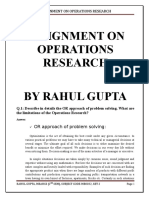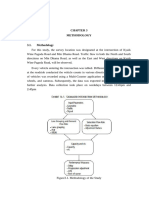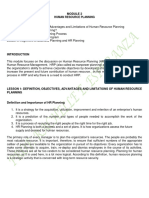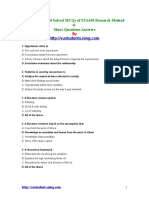5. CHAPTER 2
Uploaded by
K K LwinCopyright:
Available Formats
5. CHAPTER 2
Uploaded by
K K LwinCopyright
Available Formats
Share this document
Did you find this document useful?
Is this content inappropriate?
Copyright:
Available Formats
5. CHAPTER 2
Uploaded by
K K LwinCopyright:
Available Formats
CHAPTER 2
LITERATURE REVIEW
Any vehicle traveling on a highway will at one time or another to be parked for either
a relatively short time or a much longer time, depending on the reason for parking. The
provision of parking facilities is therefore an essential element of the highway mode of
transportation. The need for parking spaces is usually very great in areas where land uses
include business, residential, or commercial activities. The growing use of the automobile as
a personal feeder service to transit systems (“park-and-ride”) has also increased the demand
for parking spaces at transit stations. In areas of high density, where space is very expensive,
the space provided for automobiles usually has to be divided between that allocated for their
movement and that allocated for parking them.
Providing adequate parking space to meet the demand for parking in the CBD may
necessitate the provision of parking bays along curbs which reduces the capacity of the streets
and may affect the level of service. This problem usually confronts a city Chapter 4 Traffic
Engineering Studies 139 traffic engineer. The solution is not simple, since the allocation of
available space will depend on the goals of the community which the traffic engineer must
take into consideration when trying to solve the problem. Parking studies are therefore used
to determine the demand for and the supply of parking facilities in an area, the projection of
the demand, and the views of various interest groups on how best to solve the problem.
Before we discuss the details of parking studies, it is necessary to discuss the different types
of parking facilities.
2.1. Types of Parking Facilities
Parking facilities can be divided into two main groups:
1. On-Street Parking Facilities
2. Off-Street Parking Facilities
5
2.1.1. On-Street Parking Facilities
These are also known as curb facilities. Parking bays are provided alongside the curb
on one or both sides of the street. These bays can be unrestricted parking facilities if the
duration of parking is unlimited and parking is free, or they can be restricted parking facilities
if parking is limited to specific times of the day for a maximum duration. Parking at restricted
facilities may or may not be free. Restricted facilities also may be provided for specific
purposes, such as to provide handicapped parking or as bus stops or loading bays.
2.1.2. Off-Street Parking Facilities
These facilities may be privately or publicly owned; they include surface lots and
garages. Self-parking garages require that drivers park their own automobiles; attendant-
parking garages maintain personnel to park the automobiles.
2.2. Definitions of Parking Terms
Before discussing the different methods for conducting a parking study, it is necessary
to define some terms commonly used in parking studies including
1. space-hour
2. parking volume
3. parking accumulation
4. parking load
5. parking duration
6. parking turnover
2.2.1. Space-hour
In parking studies, "space hour" refers to the measurement of parking demand or
occupancy over a specific period, typically one hour, for a particular parking space or area.
It's a unit used to quantify the utilization of parking spaces, indicating how many spaces
are occupied during a given hour. By analyzing space hour data, planners can assess peak
demand times, identify parking shortages or surpluses, and make informed decisions about
parking management strategies and infrastructure improvements.
2.2.2. Parking volume
Parking volume typically refers to the total number of vehicles parked within a
given area during a specific period, often measured over a day, week, or month. It is a
crucial metric in parking studies as it helps assess the overall demand for parking in a
6
particular location. By analyzing parking volume data, planners can identify peak usage
times, estimate parking space requirements, and evaluate the effectiveness of existing
parking infrastructure. This information is essential for making informed decisions about
parking management strategies, such as implementing pricing mechanisms, expanding
parking facilities, or improving public transportation options to reduce parking demand.
2.2.3. Parking accumulation
Parking accumulation refers to the gradual build-up of parked vehicles in a specific
area over time. It is a term often used in parking studies to describe how parking demand
evolves throughout the day or during peak periods. Parking accumulation can vary
depending on factors such as the time of day, day of the week, seasonality, and the
characteristics of the area (e.g., residential, commercial, or recreational). By studying
parking accumulation patterns, planners can understand when and where parking demand
is highest, allowing them to implement appropriate management strategies to address
congestion, optimize parking utilization, and improve overall parking availability.
2.2.4. Parking load
Parking load typically refers to the level of parking demand or occupancy relative
to the available parking capacity in a given area or facility. It is often expressed as a
percentage, representing the proportion of parking spaces that are occupied at a specific
time. For example, if a parking lot has 100 spaces and 80 of them are filled, the parking
load would be 80%.
Monitoring parking load is essential for managing parking resources effectively
and ensuring that parking facilities operate efficiently. By regularly assessing parking load,
planners can identify peak usage times, anticipate potential shortages, and implement
strategies to optimize parking availability and alleviate congestion. This may include
adjusting pricing, implementing time limits, expanding parking capacity, or promoting
alternative transportation options to reduce parking demand.
2.2.5. Parking duration
Parking duration refers to the length of time a vehicle remains parked in a specific
parking space or facility. It is a key metric in parking studies used to analyze parking
behavior and patterns. By studying parking duration data, planners can understand how
7
long vehicles typically stay parked in different areas, identify short-term and long-term
parking needs, and develop appropriate parking management strategies.
Understanding parking duration is crucial for ensuring efficient turnover of parking
spaces, particularly in high-demand areas such as commercial districts or urban centers. It
can also inform decisions related to parking pricing, time limits, enforcement policies, and
the design of parking facilities to accommodate varying durations of parking needs.
2.2.6. Parking turnover
Parking turnover refers to the rate at which parking spaces are vacated and refilled
within a specific area or facility over a given period, typically measured in hours or days.
It is a critical metric in parking management and studies, indicating the efficiency with
which parking spaces are utilized.
High parking turnover is generally desirable as it reflects a healthy balance
between supply and demand, allowing more vehicles to access parking spaces within a
given timeframe. Low turnover rates can indicate either insufficient parking demand or
inadequate management strategies, leading to underutilized parking resources or
congestion due to limited availability.
By monitoring parking turnover, planners can assess the effectiveness of parking
policies, pricing structures, and enforcement measures. They can also identify areas with
low turnover and implement strategies to encourage turnover, such as adjusting parking
pricing, time limits, or improving way finding to guide drivers to available spaces more
efficiently. Ultimately, maximizing parking turnover helps optimize the use of parking
resources, enhance accessibility, and reduce congestion in urban areas.
2.3. Inventory of Existing Parking Facilities
An inventory of existing parking facilities is a detailed listing of the location and
all other relevant characteristics of each legal parking facility, private and public, in the
study area. The inventory includes both on- and off-street facilities. The relevant
characteristics usually listed include the following
• Type and number of parking spaces at each parking facility
• Times of operation and limit on duration of parking, if any • Type of ownership
(private or public)
• Parking fees, if any, and method of collection
8
• Restrictions on use (open or closed to the public)
• Other restrictions, if any (such as loading and unloading zones, bus stops, or taxi
ranks)
• Probable degree of permanency (can the facility be regarded as permanent or is it
just a temporary facility?)
The information obtained from an inventory of parking facilities is useful both to
the traffic engineer and to public agencies, such as zoning commissions and planning
departments. The inventory should be updated at regular intervals of about four to five
years.
2.4. Collection of Parking Data
2.4.1. Parking Accumulation
Accumulation data are obtained by checking the amount of parking during regular
intervals on different days of the week. The checks are usually carried out on an hourly or
2-hour basis between 6:00 a.m. and 12 midnight. The selection of the times depends on the
operation times of land-use activities that act as parking generators. For example, if a
commercial zone is included, checks should be made during the times when retail shops
are open, which may include periods up to 9:30 p.m. on some days. On the other hand, at
truck stops, the highest accumulation may occur around midnight which requires
information to be collected at that time. The information obtained is used to determine
hourly variations of parking and peak periods of parking demand.
2.4.2. Parking Turnover and Duration
Information on turnover and duration is usually obtained by collecting
data on a sample of parking spaces in a given block. This is done by recording
the license plate of the vehicle parked on each parking space in the sample at
the ends of fixed intervals during the study period. The length of the fixed
intervals depends on the maximum permissible duration. For example, if the
maximum permissible duration of parking at a curb face is 1 hour, a suitable
interval is every 20 minutes. If the permissible duration is 2 hours, checking
every 30 minutes would be appropriate. Turnover is then obtained from the
equation
9
Although the manual collection of parking data is still commonly used, it is now
possible for all parking data to be collected electronically. Some of these electronic
systems use wireless sensors to detect the arrival and departure of a vehicle at a parking
space and the information sent to a central location through the internet. An example of
this is the Spark Parking Inc. system. In addition to collecting data on parking, the Spark
Parking System can be used to collect parking fees. The system provides for drivers to
make calls soon after occupying a parking space from their mobile phones to record their
credit cards and other personal information. The credit cards are then used for automatic
payment of the parking fees.
2.5. Parking Demand
Information on parking demand is obtained by interviewing drivers at the various
parking facilities listed during the inventory. An effort should be made to interview all
drivers using the parking facilities on a typical weekday between 8:00 a.m. and 10:00 p.m.
Information sought should include (1) trip origin, (2) purpose of trip, and (3) driver’s
destination after parking. The interviewer must also note the location of the parking
facility, times of arrival and departure, and the vehicle type.
Parking interviews also can be carried out using the postcard technique, in which
stamped postcards bearing the appropriate questions and a return address are handed to
drivers or placed under windshield wipers. When this technique is used, usually only about
30 to 50 percent of the cards distributed are returned. It is therefore necessary to record the
time and the number of cards distributed at each location, because this information is
required to develop expansion factors, which are later used to expand the sample.
2.6. Analysis of Parking Data
Analysis of parking data includes summarizing, coding, and interpreting the data so
that the relevant information required for decision making can be obtained. The relevant
information includes the following:
• Number and duration for vehicles legally parked
• Number and duration for vehicles illegally parked
• Space-hours of demand for parking
• Supply of parking facilities
10
The analysis required to obtain information on the first two items is
straightforward; it usually involves simple arithmetical and statistical calculations. Data
obtained from these items are then used to determine parking space-hours.
The space-hours of demand for parking are obtained from the expression.
Where,
D = space vehicle-hours demand for a specific period of time
N = number of classes of parking duration ranges
ti = midparking duration of the ith class
ni = number of vehicles parked for the ith duration range
The space-hours of supply are obtained from the expression
Where,
S = practical number of space-hours of supply for a specific period of time
N = number of parking spaces available
ti = total length of time in hours when the ith space can be legally parked on during
the specific period
f = efficiency factor
The efficiency factor f is used to correct for time lost in each turnover. It is
determined on the basis of the best performance a parking facility is expected to produce.
Efficiency factors therefore should be determined for different types of parking facilities—for
example, surface lots, curb parking, and garages. Efficiency factors for curb parking, during
highest demand, vary from 78 percent to 96 percent; for surface lots and garages, from 75
percent to 92 percent. Average values of f are 90 percent for curb parking, 80 percent for
garages, and 85 percent for surface lots.
You might also like
- 2022 Bookmatter StatisticsForDataScientistsNo ratings yet2022 Bookmatter StatisticsForDataScientists24 pages
- A Survey of Evolution of Image Captioning PDFNo ratings yetA Survey of Evolution of Image Captioning PDF18 pages
- Query2Prod2Vec Grounded Word Embeddings For EcommerceNo ratings yetQuery2Prod2Vec Grounded Word Embeddings For Ecommerce14 pages
- IDC Executive Insights January2011 T 76-4420 PDFNo ratings yetIDC Executive Insights January2011 T 76-4420 PDF5 pages
- Data Transformation and Arima Models A SNo ratings yetData Transformation and Arima Models A S8 pages
- Data Science in E-Commerce - Report - WritingNo ratings yetData Science in E-Commerce - Report - Writing18 pages
- A Step-By-step Guide To Building A Chatbot Based On Your Own Documents With GPT - by Guodong (Troy) Zhao - BootcampNo ratings yetA Step-By-step Guide To Building A Chatbot Based On Your Own Documents With GPT - by Guodong (Troy) Zhao - Bootcamp16 pages
- Organizational Performance and Indicators: Trends and OpportunitiesNo ratings yetOrganizational Performance and Indicators: Trends and Opportunities8 pages
- Applications of Data Mining in The Banking SectorNo ratings yetApplications of Data Mining in The Banking Sector8 pages
- IEC Certification Kit: Model-Based Design For ISO 25119:2018No ratings yetIEC Certification Kit: Model-Based Design For ISO 25119:201818 pages
- PDF RESTful Web API Patterns and Practices Cookbook Connecting and Orchestrating Microservices and Distributed Data 1st Edition Mike Amundsen download100% (3)PDF RESTful Web API Patterns and Practices Cookbook Connecting and Orchestrating Microservices and Distributed Data 1st Edition Mike Amundsen download47 pages
- Introduction To Operations and Supply Chain Management100% (1)Introduction To Operations and Supply Chain Management46 pages
- Flexible Flow Shop Sheduling Problem With Machine Eligibility100% (1)Flexible Flow Shop Sheduling Problem With Machine Eligibility12 pages
- Big Data and Business Analytics: Trends, Platforms, Success Factors and ApplicationsNo ratings yetBig Data and Business Analytics: Trends, Platforms, Success Factors and Applications32 pages
- A Multi-Size Compartment Vehicle Routing Problem For Multi-Product Distribution: Models and Solution ProceduresNo ratings yetA Multi-Size Compartment Vehicle Routing Problem For Multi-Product Distribution: Models and Solution Procedures21 pages
- Contribution of Transport To Economic Development Economic Development and Transport ProjectNo ratings yetContribution of Transport To Economic Development Economic Development and Transport Project19 pages
- What Is A DSS?: Decision Support Systems Concepts, Methodologies, and Technologies: An OverviewNo ratings yetWhat Is A DSS?: Decision Support Systems Concepts, Methodologies, and Technologies: An Overview9 pages
- Big Data For Marketing Resource ReallocationNo ratings yetBig Data For Marketing Resource Reallocation31 pages
- Applications of Artificial Neural Networks in Management Science A Survey PDFNo ratings yetApplications of Artificial Neural Networks in Management Science A Survey PDF19 pages
- Comparative Study of Different Multi-Criteria Decision-Making Methods100% (1)Comparative Study of Different Multi-Criteria Decision-Making Methods4 pages
- Case Study of The Behavioural Intentions of Public Transportation Passengers in Kuala LumpurNo ratings yetCase Study of The Behavioural Intentions of Public Transportation Passengers in Kuala Lumpur14 pages
- Computational Intelligence in Expensive Optimization Problems (2010) (Attica)50% (2)Computational Intelligence in Expensive Optimization Problems (2010) (Attica)707 pages
- Data As A Service The Future of Data ManagementNo ratings yetData As A Service The Future of Data Management7 pages
- (Vijayan Sugumaran, Arun Kumar Sangaiah, ArunkumarNo ratings yet(Vijayan Sugumaran, Arun Kumar Sangaiah, Arunkumar379 pages
- Assignment On Operations Research by Rahul GuptaNo ratings yetAssignment On Operations Research by Rahul Gupta21 pages
- Object Detection and Avoidance in Unmanned Ground Vehicle Using Arduino1No ratings yetObject Detection and Avoidance in Unmanned Ground Vehicle Using Arduino14 pages
- Traffic Engineering, Operations & Safety ManualNo ratings yetTraffic Engineering, Operations & Safety Manual49 pages
- Predictive Machine Learning Applying Cross Industry Standard Process For Data Mining For The Diagnosis of Diabetes Mellitus Type 2No ratings yetPredictive Machine Learning Applying Cross Industry Standard Process For Data Mining For The Diagnosis of Diabetes Mellitus Type 214 pages
- Critical infrastructure protection Complete Self-Assessment GuideFrom EverandCritical infrastructure protection Complete Self-Assessment GuideNo ratings yet
- Performance Studies on Pavements Using Chemically Stabilized Soils_21c9405f-654d-4206-A789-A37ba34c70b7No ratings yetPerformance Studies on Pavements Using Chemically Stabilized Soils_21c9405f-654d-4206-A789-A37ba34c70b76 pages
- Organizational Climate and Child Welfare Workers' Degree of Intent To Leave The Job Evidence From New York PDFNo ratings yetOrganizational Climate and Child Welfare Workers' Degree of Intent To Leave The Job Evidence From New York PDF8 pages
- HR Service Providers Directory: Hong Kong Institute of Human Resource ManagementNo ratings yetHR Service Providers Directory: Hong Kong Institute of Human Resource Management52 pages
- Effect of Inventory Management PracticesNo ratings yetEffect of Inventory Management Practices12 pages
- The Rise of Robots in China: Hong Cheng, Ruixue Jia, Dandan Li, and Hongbin LiNo ratings yetThe Rise of Robots in China: Hong Cheng, Ruixue Jia, Dandan Li, and Hongbin Li20 pages
- Employee Retention in The Pharmaceutical Companies: Case of Lebanon100% (1)Employee Retention in The Pharmaceutical Companies: Case of Lebanon18 pages
- Employee Turnover and Retention An Overv PDFNo ratings yetEmployee Turnover and Retention An Overv PDF6 pages
- Dynamic Effects of Teacher Turnover On The Quality of InstructionNo ratings yetDynamic Effects of Teacher Turnover On The Quality of Instruction17 pages
- Busm4185A - Introduction To Management Individual Assignment Case Study AnalysisNo ratings yetBusm4185A - Introduction To Management Individual Assignment Case Study Analysis9 pages
- More Than 2000 Solved MCQsof STA630 Research Method Short Question AnswerNo ratings yetMore Than 2000 Solved MCQsof STA630 Research Method Short Question Answer337 pages
- Business Studies Paper 1 November 2004 PDFNo ratings yetBusiness Studies Paper 1 November 2004 PDF4 pages
- Importance of HR Audit For An OrganizationNo ratings yetImportance of HR Audit For An Organization10 pages
- Chapter One 1.1 Background of The StudyNo ratings yetChapter One 1.1 Background of The Study19 pages
- Job Satisfaction Paper... Zewdu Tefera.... FinalNo ratings yetJob Satisfaction Paper... Zewdu Tefera.... Final87 pages
- 8th Chapter 10 - International Human Resource ManagementNo ratings yet8th Chapter 10 - International Human Resource Management40 pages
- Difference Between Recruitment and SelectionNo ratings yetDifference Between Recruitment and Selection8 pages
- Employer Checklist On Workplace Environment and SatisfactionNo ratings yetEmployer Checklist On Workplace Environment and Satisfaction2 pages
- Query2Prod2Vec Grounded Word Embeddings For EcommerceQuery2Prod2Vec Grounded Word Embeddings For Ecommerce
- A Step-By-step Guide To Building A Chatbot Based On Your Own Documents With GPT - by Guodong (Troy) Zhao - BootcampA Step-By-step Guide To Building A Chatbot Based On Your Own Documents With GPT - by Guodong (Troy) Zhao - Bootcamp
- Organizational Performance and Indicators: Trends and OpportunitiesOrganizational Performance and Indicators: Trends and Opportunities
- IEC Certification Kit: Model-Based Design For ISO 25119:2018IEC Certification Kit: Model-Based Design For ISO 25119:2018
- PDF RESTful Web API Patterns and Practices Cookbook Connecting and Orchestrating Microservices and Distributed Data 1st Edition Mike Amundsen downloadPDF RESTful Web API Patterns and Practices Cookbook Connecting and Orchestrating Microservices and Distributed Data 1st Edition Mike Amundsen download
- Introduction To Operations and Supply Chain ManagementIntroduction To Operations and Supply Chain Management
- Flexible Flow Shop Sheduling Problem With Machine EligibilityFlexible Flow Shop Sheduling Problem With Machine Eligibility
- Big Data and Business Analytics: Trends, Platforms, Success Factors and ApplicationsBig Data and Business Analytics: Trends, Platforms, Success Factors and Applications
- A Multi-Size Compartment Vehicle Routing Problem For Multi-Product Distribution: Models and Solution ProceduresA Multi-Size Compartment Vehicle Routing Problem For Multi-Product Distribution: Models and Solution Procedures
- Contribution of Transport To Economic Development Economic Development and Transport ProjectContribution of Transport To Economic Development Economic Development and Transport Project
- What Is A DSS?: Decision Support Systems Concepts, Methodologies, and Technologies: An OverviewWhat Is A DSS?: Decision Support Systems Concepts, Methodologies, and Technologies: An Overview
- Applications of Artificial Neural Networks in Management Science A Survey PDFApplications of Artificial Neural Networks in Management Science A Survey PDF
- Comparative Study of Different Multi-Criteria Decision-Making MethodsComparative Study of Different Multi-Criteria Decision-Making Methods
- Case Study of The Behavioural Intentions of Public Transportation Passengers in Kuala LumpurCase Study of The Behavioural Intentions of Public Transportation Passengers in Kuala Lumpur
- Computational Intelligence in Expensive Optimization Problems (2010) (Attica)Computational Intelligence in Expensive Optimization Problems (2010) (Attica)
- (Vijayan Sugumaran, Arun Kumar Sangaiah, Arunkumar(Vijayan Sugumaran, Arun Kumar Sangaiah, Arunkumar
- Object Detection and Avoidance in Unmanned Ground Vehicle Using Arduino1Object Detection and Avoidance in Unmanned Ground Vehicle Using Arduino1
- Predictive Machine Learning Applying Cross Industry Standard Process For Data Mining For The Diagnosis of Diabetes Mellitus Type 2Predictive Machine Learning Applying Cross Industry Standard Process For Data Mining For The Diagnosis of Diabetes Mellitus Type 2
- Feature engineering Complete Self-Assessment GuideFrom EverandFeature engineering Complete Self-Assessment Guide
- Critical infrastructure protection Complete Self-Assessment GuideFrom EverandCritical infrastructure protection Complete Self-Assessment Guide
- Performance Studies on Pavements Using Chemically Stabilized Soils_21c9405f-654d-4206-A789-A37ba34c70b7Performance Studies on Pavements Using Chemically Stabilized Soils_21c9405f-654d-4206-A789-A37ba34c70b7
- Organizational Climate and Child Welfare Workers' Degree of Intent To Leave The Job Evidence From New York PDFOrganizational Climate and Child Welfare Workers' Degree of Intent To Leave The Job Evidence From New York PDF
- HR Service Providers Directory: Hong Kong Institute of Human Resource ManagementHR Service Providers Directory: Hong Kong Institute of Human Resource Management
- The Rise of Robots in China: Hong Cheng, Ruixue Jia, Dandan Li, and Hongbin LiThe Rise of Robots in China: Hong Cheng, Ruixue Jia, Dandan Li, and Hongbin Li
- Employee Retention in The Pharmaceutical Companies: Case of LebanonEmployee Retention in The Pharmaceutical Companies: Case of Lebanon
- Dynamic Effects of Teacher Turnover On The Quality of InstructionDynamic Effects of Teacher Turnover On The Quality of Instruction
- Busm4185A - Introduction To Management Individual Assignment Case Study AnalysisBusm4185A - Introduction To Management Individual Assignment Case Study Analysis
- More Than 2000 Solved MCQsof STA630 Research Method Short Question AnswerMore Than 2000 Solved MCQsof STA630 Research Method Short Question Answer
- 8th Chapter 10 - International Human Resource Management8th Chapter 10 - International Human Resource Management
- Employer Checklist On Workplace Environment and SatisfactionEmployer Checklist On Workplace Environment and Satisfaction












































































































